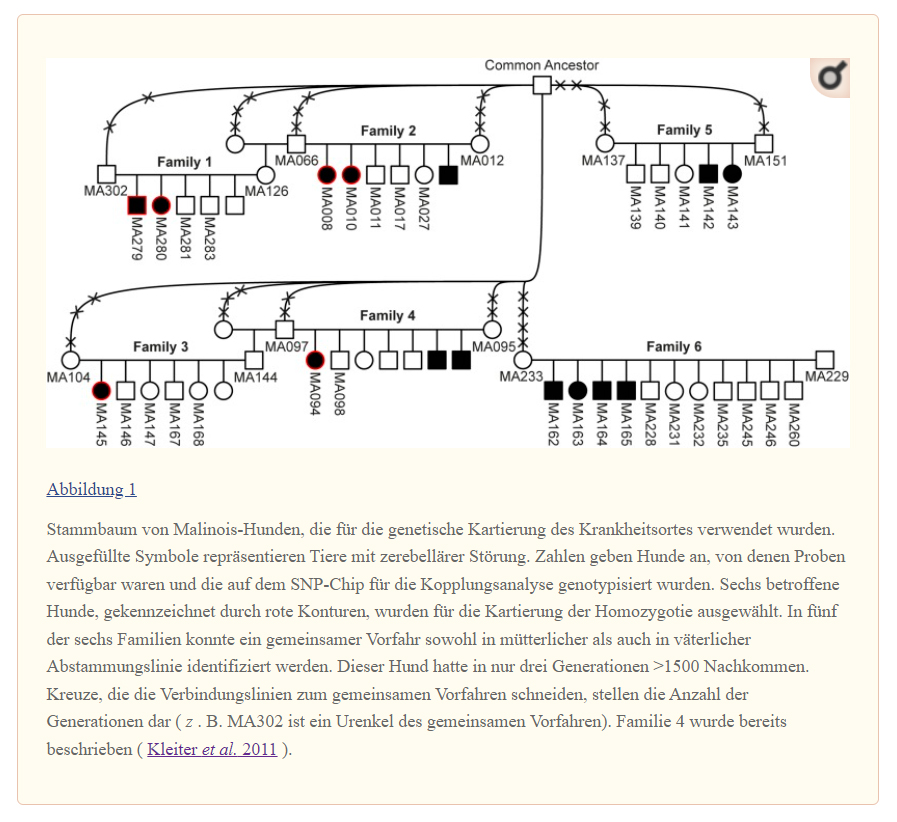Spongy Degeneration with Cerebellar Ataxia (SDCA1)
22.01.2023 15:08von DR. MED. VET. SUE CHANDRARATNE
Spongy Degeneration with Cerebellar Ataxia (SDCA1) is a neurodegenerative disease in Belgian Shepherds.
This disease is caused by a c.986T>C point mutation in the KCNJ10 gene. This gene encodes potassium channels found in the central nervous system, eyes, inner ear and kidneys. Disruption of the function of the potassium channel in the cerebellum leads to accumulation of potassium in the extracellular space, reduction in membrane potential and the subsequent occurrence of neurological seizures.
In the Malinois study, clinical signs and histological findings were primarily located in the cerebellum. The cerebellum is important for balance and coordination. Together with the cerebrum, it coordinates the muscles and thus the movements. It also makes a significant contribution to maintaining muscle tension in the body. While the cerebrum is primarily responsible for conscious movements, the cerebellum controls movement sequences that have already been learned. The first symptoms can appear before the age of 8 weeks.
It is described that the symptoms in puppies are usually noticed by the breeder between 4.5 and 8.5 weeks of age. The affected puppies are characterized by a wide-legged gait with the rear extremities. In this way, the puppies try to maintain stability and improve movement coordination. In addition, trembling, stumbling, tumbling, jumping and falling over were observed in puppies affected by this defect. Muscle cramps can also occur individually due to the stress experienced or after strenuous exercise. Due to the poor prognosis, the affected puppies usually have to euthanized before the 20th week.
Also, in America, case of a pair of siblings experiencing their first birthday was reported. SDCA1 is an autosomal recessive disease.
The birth of affected puppies can be safely ruled out if at least one of the two breeding partners is free of the genetic defect.
In humans, there is a disease with the same gene defect (mutation in the KCNJ10 gene): SeSAME syndrome occurs in infancy and the neonatal period and is characterized by cerebral spasms, sensorineural hearing loss, ataxia, intellectual deficits and electrolyte imbalances. Here, too, inheritance is autosomal recessive.
The performance lines of the Belgian shepherd are particularly affected - especially the Malinois variety.
The statistics from our database, the numbers are regularly updated:
Genetic scheme of the animals involved in the study and their relationships

Case study 1: "C-litter unter schwarzer Flagge"
In 2012 Mareike Wollschläger made public that in her C-litter 3 of 6 puppies at 5 weeks had progressive symptoms with seizures and ataxia. The affected puppies had to be euthanized at 8, 9.5 and 10 weeks.
Zitat
The seizures began at about 5 weeks of age. Shortly after the begin of feeding, the affected puppy began to cramp slightly and sagged with its rear end. Sometimes the head also shook a little and the movements were uncoordinated. However, the puppy remained fully responsive and did not appear to have any disturbances - it continued to eat while sitting or lying down and did not seem to notice anything unusual. It almost looked a little like a brief circulatory problem. Relatively soon, independently of the seizures, the first slight restrictions in movement set in - the coordination of the hind limbs became worse.
http://www.malinois-unter-schwarzer-flagge.de/html/ataxie
The breeder had been massively attacked at the time because of the publication and had received threats from lawyers, etc., but she fought her way through and thanks to her, in cooperation with Nina Helbing (case study 2), the SDCA-1 genetic test is now available. So nobody has to go through the terrible weeks anymore that she went through with her puppies back then. Many thanks Mareike and Nina for your commitment!!
Case study 2: „D-Wurf von Malihatten“
Litter size 4/1
Affected puppies 1/1
The first symptoms had been noticed in a bitch at 6 weeks after deworming. She showed an unsteady gait, tripped over her own paws, drooled and showed spasms on her face. The drooling lasted about 30 minutes, the facial spasms about 5 minutes. After that, the bitch was completely normal again and showed no symptoms for the following 11 days. After the vaccination, she began to cramp again, this time generalized, for about 5 minutes, drooled for about 20 minutes and then repeatedly had problems with her gait (stumbling or falling over in turns). As she got older, problems with walking became ubiquitous. Stressful situations such as driving a car or boxing training triggered focal seizures, depending on the stress level, the seizures lasted between 2 minutes and (the last one) 15 minutes. The bitch was euthanized at 12 weeks. In one male dog, the symptoms only appeared at 9 weeks of age (very mild) and at first only showed themselves in a "clumsy" gait, but the gait got worse week by week. But the male had no seizures. The male had to be euthanized at the age of 14 weeks because he could not walk any more. It was also notable that the affected puppies had to eat a lot from the age of 8 weeks in order to maintain their weight.
Below you will find the autopsy findings of a puppy:
In the autopsy finding there were found big pathologic changes in the cerebellum and spinal cord. The diagnosis of spongy degeneration in the central nervous system was expressed.
Case study 3: Malinois puppy
In September 2021, a Malinois puppy with about 7-8 weeks of age was presented with neurological deficits in a clinic: the owners stated that he had had this since the fourth week, but that it got better at times. The puppy was handed over in Serbia at the age of four weeks and came from Serbia to Germany at the age of 6 weeks. Since the dog showed neurological symptoms and there were children living in the household (abroad, rabies quarantine), an animal shelter was commissioned by the veterinary office to house the dog in an isolation ward and to pick it up from the veterinary clinic. The puppy could hardly stand and sit, trembled, but was quite responsive.
After research and the advice of a veterinarian, blood was drawn relatively quickly to test for SDCA. The puppy was not able to stand, walk or sit for the first few days, this changed after a while and suddenly he was standing up in the morning. Step by step we practiced running under quarantine conditions - it got better and better.
In between, he had muscle spasms / epileptic seizures, but these quickly passed. This little dog had a stronger will to survive than an entire army.
After 14 days the results came and it was clear that he had SDCA1. But the puppy got better and better - the quarantine was over and he was allowed to move to an employee of the animal shelter. No more seizures could be observed and she decided to offer him a nice life as long as long it lasted. Everything was going wonderfully until the puppy had to be left “alone” for the first time or in a strange environment. There he had his first attack in the care of a boarding house.
Back at the animal shelter in the evening, there were more seizures, and despite the maximum dose of diazepam (antiepileptic) he went into epilepticus status and had to be euthanized that night.
Summary:
Attached you will find a compilation of case studies. The first video sequence shows “Dallas von Malihattan”, who was born before tests became available (case study 2). The other dogs are unfortunately current cases. The puppies do not necessarily die at the breeder’s. These dogs were sold to private dog owners or handed over to animal welfare (case study 3). Had their breeders tested the parents, their suffering could have been prevented.
Many thanks to everyone, who supported us with video material and case descriptions.


Sources:
Kleiter, M., Högler, S., Kneissl, S., Url, A., & Leschnik, M. (2011). Spongy degeneration with cerebellar ataxia in Malinois puppies: a hereditary autosomal recessive disorder?. Journal of veterinary internal medicine, 25(3), 490-496.
Mauri, Nico, et al. „A Missense Variant in KCNJ10 in Belgian Shepherd Dogs Affected by Spongy Degeneration with Cerebellar Ataxia (SDCA1).“ G3: Genes| Genomes| Genetics (2016): g3-116.
Van Poucke, M., Stee, K., Bhatti, S. F., Vanhaesebrouck, A., Bosseler, L., Peelman, L. J., & Van Ham, L. (2017). The novel homozygous KCNJ10 c. 986T> C (p.(Leu329Pro)) variant is pathogenic for the SeSAME/EAST homologue in Malinois dogs. European Journal of Human Genetics, 25(2), 222-226.
laboklin.de/de/leistungen/genetik/erbkrankheiten/hund/spongioese-degeneration-mit-cerebellaerer-ataxie-typ-1-sdca1/
http://www.genomia.cz/de/test/sdca1/
http://www.orpha.net/consor/cgi-bin/OC_E...e&Expert=199343
pubmed.ncbi.nlm.nih.gov/29722015/
ncbi.nlm.nih.gov/pmc/articles/PMC5386501/
Informationen zu diesem Artikel
-
Erstellt von:
Astrid Hübner
Kategorie: English language articles
22.01.2023 15:08:00 Uhr
zuletzt bearbeitet: 15.12.2023 11:31 - Keine Kommentare
Kommentare
Der Captcha wurde falsch eingeben.
Sie haben zu viele Links in Ihrem Beitrag. Maximal dürfen Links gesetzt werden.
Sie haben zu viele Bilder in Ihrem Beitrag. Maximal dürfen Bilder verwendet werden.
Sie haben zu viele animierte Bilder in Ihrem Beitrag. Maximal dürfen animierte Bilder verwendet werden.
Ein in Ihrem Beitrag verwendetes Bild überschreitet die zulässige Breite, die vom Administrator des Forums festgelegt wurde. Die maximal erlaubte Breite sind Pixel.
Ein in Ihrem Beitrag verwendetes Bild überschreitet die zulässige Höhe, die vom Administrator des Forums festgelegt wurde. Die maximal erlaubte Höhe sind Pixel.
Der eingegebene Text ist zu lang (maximal 65.500 Zeichen).
Sie dürfen erst in Tagen Links zu externen Webseiten posten.
Sie dürfen erst nach Beiträgen Links zu externen Webseiten posten
Bitte lösen Sie das Captcha, um auch als Gast Links in diesem Forum zu posten.
Gäste können leider keine Links zu externen Seiten posten.
Bitte entfernen Sie folgende Links, um den Beitrag zu speichern:
